A Comprehensive Look at Challenges in Organizational Change Management
VerifiedAdded on 2023/06/12
|10
|3044
|408
Essay
AI Summary
This essay explores the multifaceted challenges within organizational change management. It delves into issues such as resistance to change, often politically motivated and exhibited through passive-aggressive behavior, and the critical need for understanding an organization's current state before implementing changes. The discussion extends to the complexities of integrating changes within a dynamic environment, the impact of competitive forces necessitating rapid and potentially risky transformations, and the inherent difficulties arising from organizational complexity. Further challenges discussed include the importance of stepwise planning, achieving consensus among stakeholders, effective communication to mitigate fear and uncertainty, and addressing employee resistance by providing training and support. The essay also highlights the significance of employee involvement, the need for a robust communication strategy, and the consideration of cultural shifts alongside structural changes. The critique acknowledges the varying perspectives of different authors but notes their common ground, emphasizing the importance of thorough research, detailed explanations, and actionable solutions to overcome these challenges. The essay concludes by advocating for a balanced approach that considers both organizational and employee perspectives to foster successful change management initiatives.
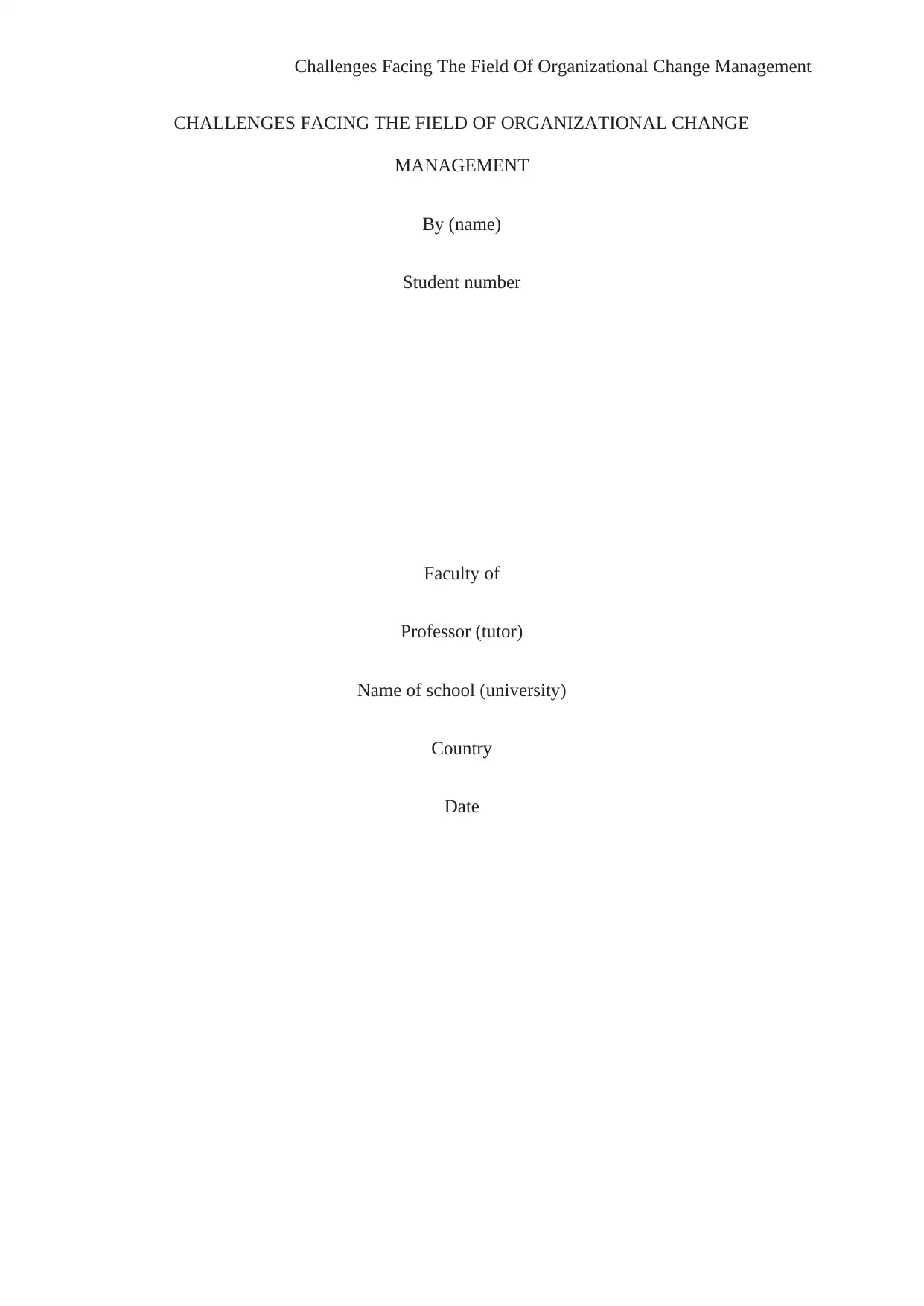
Challenges Facing The Field Of Organizational Change Management
CHALLENGES FACING THE FIELD OF ORGANIZATIONAL CHANGE
MANAGEMENT
By (name)
Student number
Faculty of
Professor (tutor)
Name of school (university)
Country
Date
CHALLENGES FACING THE FIELD OF ORGANIZATIONAL CHANGE
MANAGEMENT
By (name)
Student number
Faculty of
Professor (tutor)
Name of school (university)
Country
Date
Paraphrase This Document
Need a fresh take? Get an instant paraphrase of this document with our AI Paraphraser
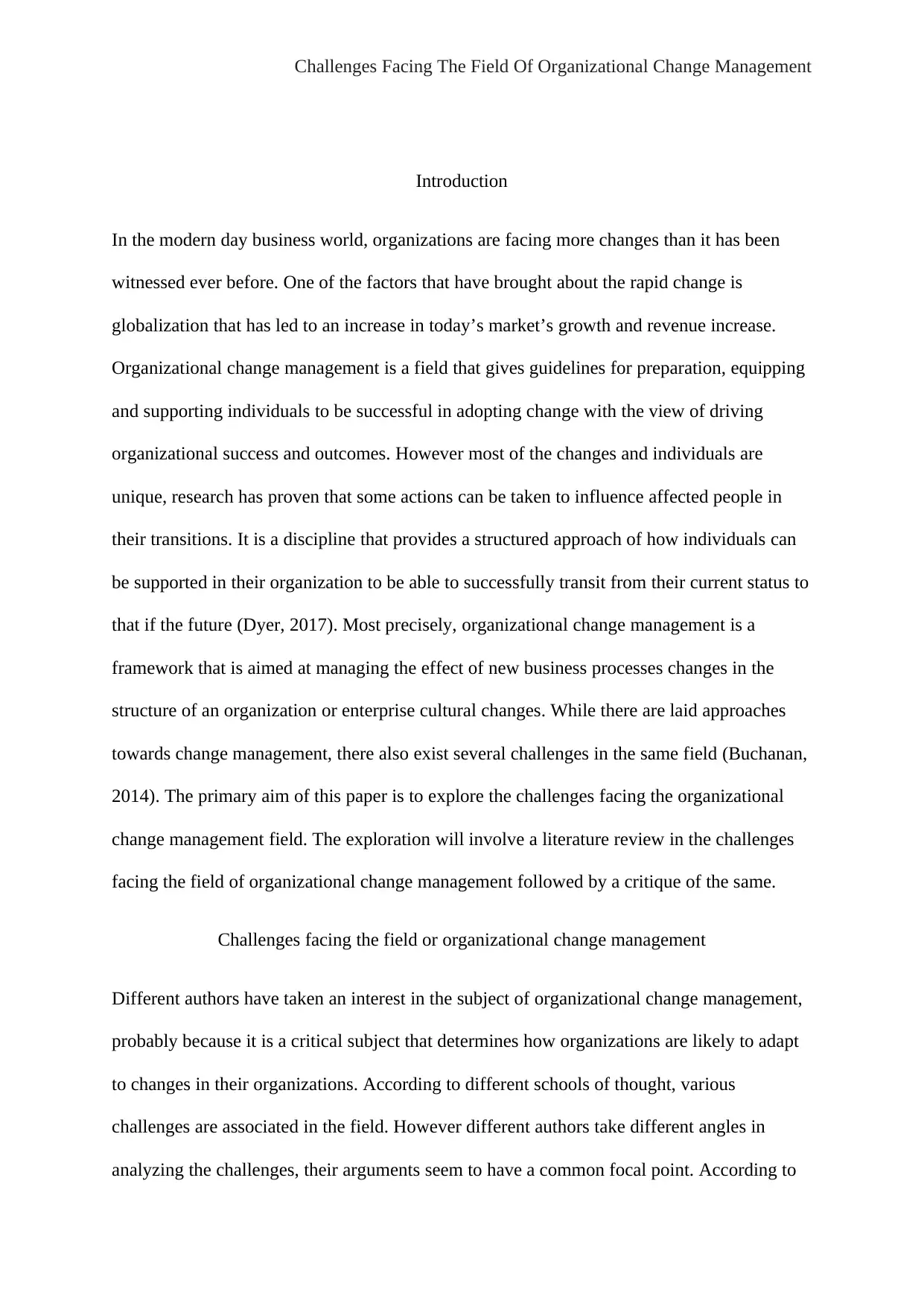
Challenges Facing The Field Of Organizational Change Management
Introduction
In the modern day business world, organizations are facing more changes than it has been
witnessed ever before. One of the factors that have brought about the rapid change is
globalization that has led to an increase in today’s market’s growth and revenue increase.
Organizational change management is a field that gives guidelines for preparation, equipping
and supporting individuals to be successful in adopting change with the view of driving
organizational success and outcomes. However most of the changes and individuals are
unique, research has proven that some actions can be taken to influence affected people in
their transitions. It is a discipline that provides a structured approach of how individuals can
be supported in their organization to be able to successfully transit from their current status to
that if the future (Dyer, 2017). Most precisely, organizational change management is a
framework that is aimed at managing the effect of new business processes changes in the
structure of an organization or enterprise cultural changes. While there are laid approaches
towards change management, there also exist several challenges in the same field (Buchanan,
2014). The primary aim of this paper is to explore the challenges facing the organizational
change management field. The exploration will involve a literature review in the challenges
facing the field of organizational change management followed by a critique of the same.
Challenges facing the field or organizational change management
Different authors have taken an interest in the subject of organizational change management,
probably because it is a critical subject that determines how organizations are likely to adapt
to changes in their organizations. According to different schools of thought, various
challenges are associated in the field. However different authors take different angles in
analyzing the challenges, their arguments seem to have a common focal point. According to
Introduction
In the modern day business world, organizations are facing more changes than it has been
witnessed ever before. One of the factors that have brought about the rapid change is
globalization that has led to an increase in today’s market’s growth and revenue increase.
Organizational change management is a field that gives guidelines for preparation, equipping
and supporting individuals to be successful in adopting change with the view of driving
organizational success and outcomes. However most of the changes and individuals are
unique, research has proven that some actions can be taken to influence affected people in
their transitions. It is a discipline that provides a structured approach of how individuals can
be supported in their organization to be able to successfully transit from their current status to
that if the future (Dyer, 2017). Most precisely, organizational change management is a
framework that is aimed at managing the effect of new business processes changes in the
structure of an organization or enterprise cultural changes. While there are laid approaches
towards change management, there also exist several challenges in the same field (Buchanan,
2014). The primary aim of this paper is to explore the challenges facing the organizational
change management field. The exploration will involve a literature review in the challenges
facing the field of organizational change management followed by a critique of the same.
Challenges facing the field or organizational change management
Different authors have taken an interest in the subject of organizational change management,
probably because it is a critical subject that determines how organizations are likely to adapt
to changes in their organizations. According to different schools of thought, various
challenges are associated in the field. However different authors take different angles in
analyzing the challenges, their arguments seem to have a common focal point. According to
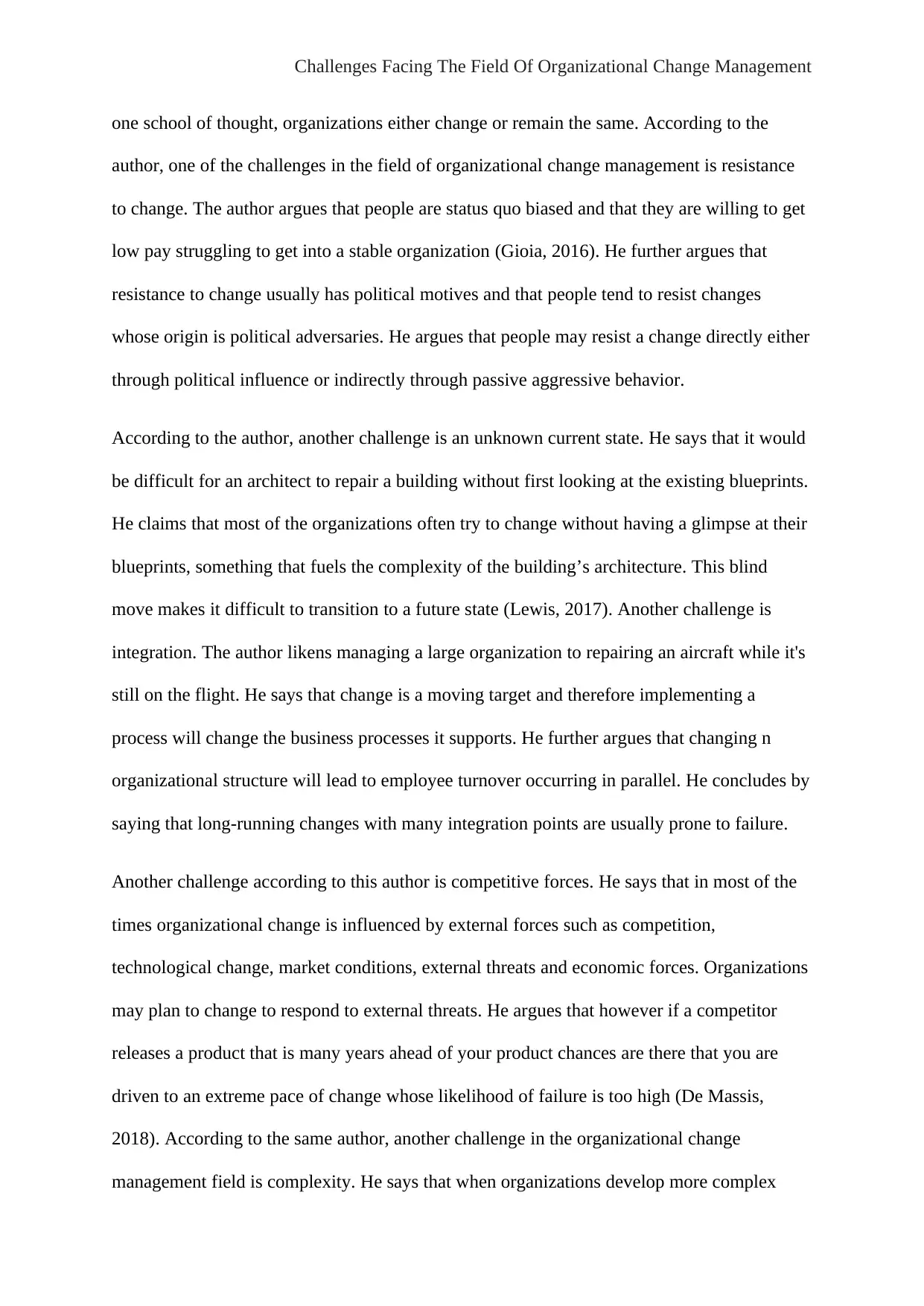
Challenges Facing The Field Of Organizational Change Management
one school of thought, organizations either change or remain the same. According to the
author, one of the challenges in the field of organizational change management is resistance
to change. The author argues that people are status quo biased and that they are willing to get
low pay struggling to get into a stable organization (Gioia, 2016). He further argues that
resistance to change usually has political motives and that people tend to resist changes
whose origin is political adversaries. He argues that people may resist a change directly either
through political influence or indirectly through passive aggressive behavior.
According to the author, another challenge is an unknown current state. He says that it would
be difficult for an architect to repair a building without first looking at the existing blueprints.
He claims that most of the organizations often try to change without having a glimpse at their
blueprints, something that fuels the complexity of the building’s architecture. This blind
move makes it difficult to transition to a future state (Lewis, 2017). Another challenge is
integration. The author likens managing a large organization to repairing an aircraft while it's
still on the flight. He says that change is a moving target and therefore implementing a
process will change the business processes it supports. He further argues that changing n
organizational structure will lead to employee turnover occurring in parallel. He concludes by
saying that long-running changes with many integration points are usually prone to failure.
Another challenge according to this author is competitive forces. He says that in most of the
times organizational change is influenced by external forces such as competition,
technological change, market conditions, external threats and economic forces. Organizations
may plan to change to respond to external threats. He argues that however if a competitor
releases a product that is many years ahead of your product chances are there that you are
driven to an extreme pace of change whose likelihood of failure is too high (De Massis,
2018). According to the same author, another challenge in the organizational change
management field is complexity. He says that when organizations develop more complex
one school of thought, organizations either change or remain the same. According to the
author, one of the challenges in the field of organizational change management is resistance
to change. The author argues that people are status quo biased and that they are willing to get
low pay struggling to get into a stable organization (Gioia, 2016). He further argues that
resistance to change usually has political motives and that people tend to resist changes
whose origin is political adversaries. He argues that people may resist a change directly either
through political influence or indirectly through passive aggressive behavior.
According to the author, another challenge is an unknown current state. He says that it would
be difficult for an architect to repair a building without first looking at the existing blueprints.
He claims that most of the organizations often try to change without having a glimpse at their
blueprints, something that fuels the complexity of the building’s architecture. This blind
move makes it difficult to transition to a future state (Lewis, 2017). Another challenge is
integration. The author likens managing a large organization to repairing an aircraft while it's
still on the flight. He says that change is a moving target and therefore implementing a
process will change the business processes it supports. He further argues that changing n
organizational structure will lead to employee turnover occurring in parallel. He concludes by
saying that long-running changes with many integration points are usually prone to failure.
Another challenge according to this author is competitive forces. He says that in most of the
times organizational change is influenced by external forces such as competition,
technological change, market conditions, external threats and economic forces. Organizations
may plan to change to respond to external threats. He argues that however if a competitor
releases a product that is many years ahead of your product chances are there that you are
driven to an extreme pace of change whose likelihood of failure is too high (De Massis,
2018). According to the same author, another challenge in the organizational change
management field is complexity. He says that when organizations develop more complex
⊘ This is a preview!⊘
Do you want full access?
Subscribe today to unlock all pages.

Trusted by 1+ million students worldwide
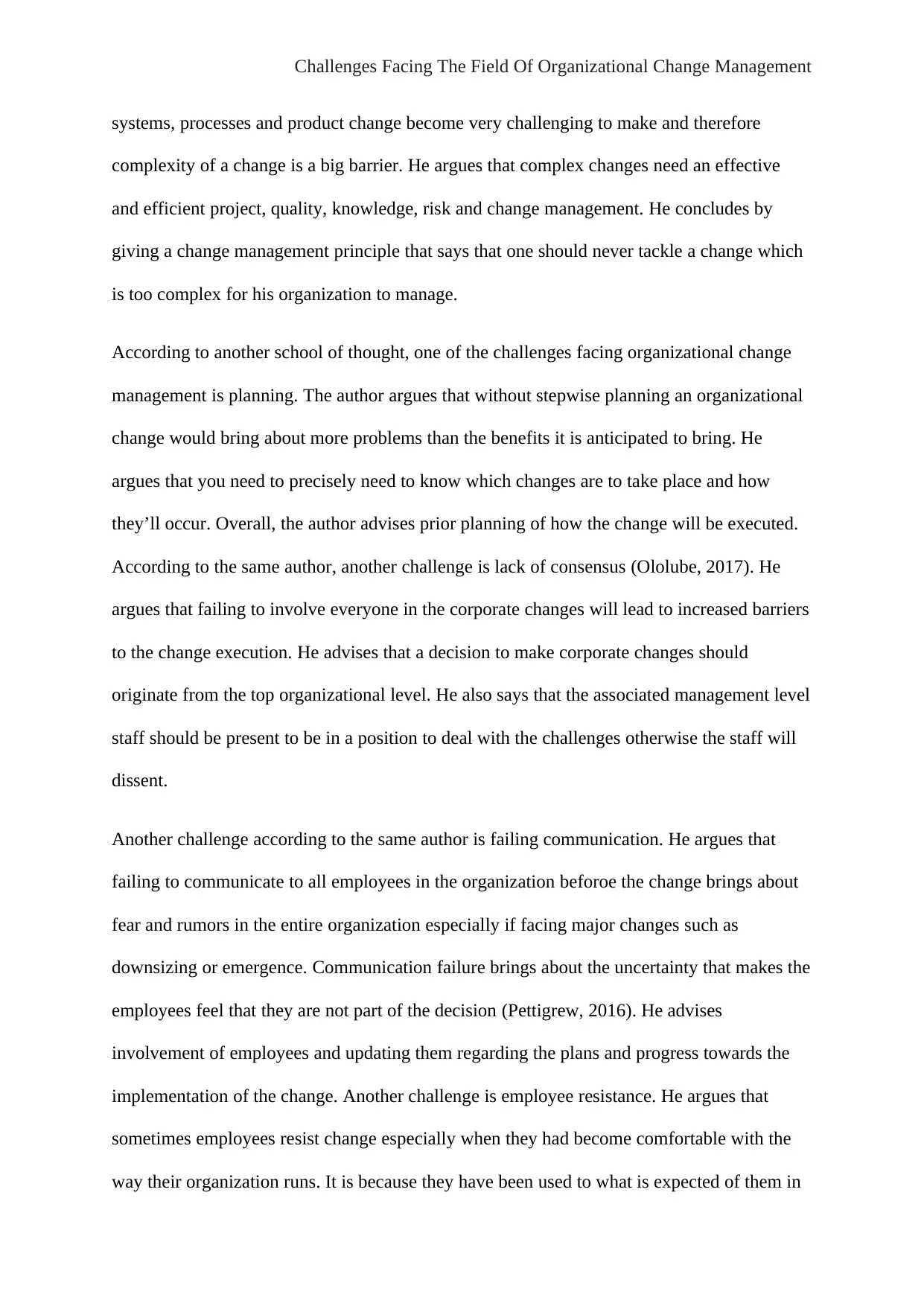
Challenges Facing The Field Of Organizational Change Management
systems, processes and product change become very challenging to make and therefore
complexity of a change is a big barrier. He argues that complex changes need an effective
and efficient project, quality, knowledge, risk and change management. He concludes by
giving a change management principle that says that one should never tackle a change which
is too complex for his organization to manage.
According to another school of thought, one of the challenges facing organizational change
management is planning. The author argues that without stepwise planning an organizational
change would bring about more problems than the benefits it is anticipated to bring. He
argues that you need to precisely need to know which changes are to take place and how
they’ll occur. Overall, the author advises prior planning of how the change will be executed.
According to the same author, another challenge is lack of consensus (Ololube, 2017). He
argues that failing to involve everyone in the corporate changes will lead to increased barriers
to the change execution. He advises that a decision to make corporate changes should
originate from the top organizational level. He also says that the associated management level
staff should be present to be in a position to deal with the challenges otherwise the staff will
dissent.
Another challenge according to the same author is failing communication. He argues that
failing to communicate to all employees in the organization beforoe the change brings about
fear and rumors in the entire organization especially if facing major changes such as
downsizing or emergence. Communication failure brings about the uncertainty that makes the
employees feel that they are not part of the decision (Pettigrew, 2016). He advises
involvement of employees and updating them regarding the plans and progress towards the
implementation of the change. Another challenge is employee resistance. He argues that
sometimes employees resist change especially when they had become comfortable with the
way their organization runs. It is because they have been used to what is expected of them in
systems, processes and product change become very challenging to make and therefore
complexity of a change is a big barrier. He argues that complex changes need an effective
and efficient project, quality, knowledge, risk and change management. He concludes by
giving a change management principle that says that one should never tackle a change which
is too complex for his organization to manage.
According to another school of thought, one of the challenges facing organizational change
management is planning. The author argues that without stepwise planning an organizational
change would bring about more problems than the benefits it is anticipated to bring. He
argues that you need to precisely need to know which changes are to take place and how
they’ll occur. Overall, the author advises prior planning of how the change will be executed.
According to the same author, another challenge is lack of consensus (Ololube, 2017). He
argues that failing to involve everyone in the corporate changes will lead to increased barriers
to the change execution. He advises that a decision to make corporate changes should
originate from the top organizational level. He also says that the associated management level
staff should be present to be in a position to deal with the challenges otherwise the staff will
dissent.
Another challenge according to the same author is failing communication. He argues that
failing to communicate to all employees in the organization beforoe the change brings about
fear and rumors in the entire organization especially if facing major changes such as
downsizing or emergence. Communication failure brings about the uncertainty that makes the
employees feel that they are not part of the decision (Pettigrew, 2016). He advises
involvement of employees and updating them regarding the plans and progress towards the
implementation of the change. Another challenge is employee resistance. He argues that
sometimes employees resist change especially when they had become comfortable with the
way their organization runs. It is because they have been used to what is expected of them in
Paraphrase This Document
Need a fresh take? Get an instant paraphrase of this document with our AI Paraphraser
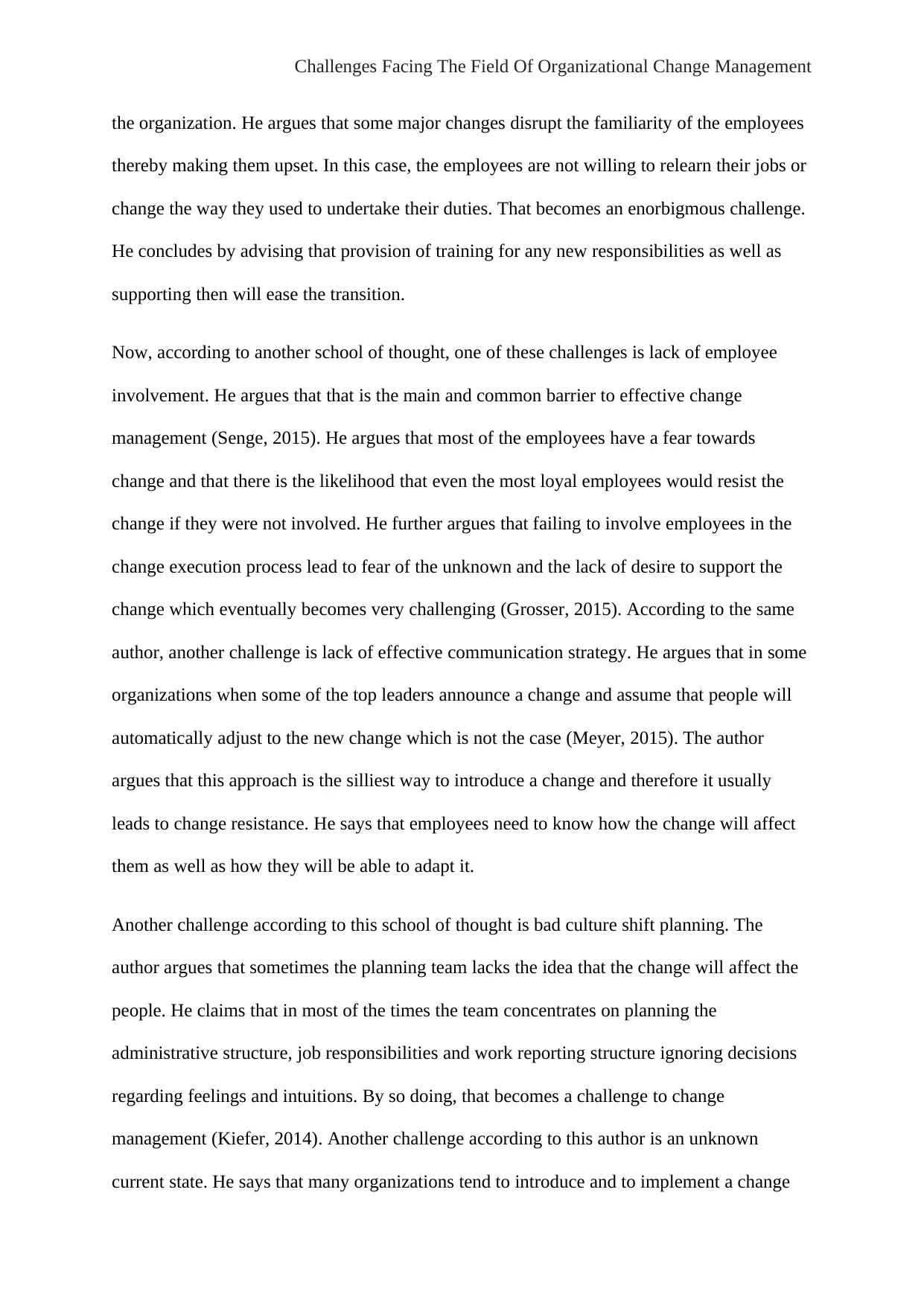
Challenges Facing The Field Of Organizational Change Management
the organization. He argues that some major changes disrupt the familiarity of the employees
thereby making them upset. In this case, the employees are not willing to relearn their jobs or
change the way they used to undertake their duties. That becomes an enorbigmous challenge.
He concludes by advising that provision of training for any new responsibilities as well as
supporting then will ease the transition.
Now, according to another school of thought, one of these challenges is lack of employee
involvement. He argues that that is the main and common barrier to effective change
management (Senge, 2015). He argues that most of the employees have a fear towards
change and that there is the likelihood that even the most loyal employees would resist the
change if they were not involved. He further argues that failing to involve employees in the
change execution process lead to fear of the unknown and the lack of desire to support the
change which eventually becomes very challenging (Grosser, 2015). According to the same
author, another challenge is lack of effective communication strategy. He argues that in some
organizations when some of the top leaders announce a change and assume that people will
automatically adjust to the new change which is not the case (Meyer, 2015). The author
argues that this approach is the silliest way to introduce a change and therefore it usually
leads to change resistance. He says that employees need to know how the change will affect
them as well as how they will be able to adapt it.
Another challenge according to this school of thought is bad culture shift planning. The
author argues that sometimes the planning team lacks the idea that the change will affect the
people. He claims that in most of the times the team concentrates on planning the
administrative structure, job responsibilities and work reporting structure ignoring decisions
regarding feelings and intuitions. By so doing, that becomes a challenge to change
management (Kiefer, 2014). Another challenge according to this author is an unknown
current state. He says that many organizations tend to introduce and to implement a change
the organization. He argues that some major changes disrupt the familiarity of the employees
thereby making them upset. In this case, the employees are not willing to relearn their jobs or
change the way they used to undertake their duties. That becomes an enorbigmous challenge.
He concludes by advising that provision of training for any new responsibilities as well as
supporting then will ease the transition.
Now, according to another school of thought, one of these challenges is lack of employee
involvement. He argues that that is the main and common barrier to effective change
management (Senge, 2015). He argues that most of the employees have a fear towards
change and that there is the likelihood that even the most loyal employees would resist the
change if they were not involved. He further argues that failing to involve employees in the
change execution process lead to fear of the unknown and the lack of desire to support the
change which eventually becomes very challenging (Grosser, 2015). According to the same
author, another challenge is lack of effective communication strategy. He argues that in some
organizations when some of the top leaders announce a change and assume that people will
automatically adjust to the new change which is not the case (Meyer, 2015). The author
argues that this approach is the silliest way to introduce a change and therefore it usually
leads to change resistance. He says that employees need to know how the change will affect
them as well as how they will be able to adapt it.
Another challenge according to this school of thought is bad culture shift planning. The
author argues that sometimes the planning team lacks the idea that the change will affect the
people. He claims that in most of the times the team concentrates on planning the
administrative structure, job responsibilities and work reporting structure ignoring decisions
regarding feelings and intuitions. By so doing, that becomes a challenge to change
management (Kiefer, 2014). Another challenge according to this author is an unknown
current state. He says that many organizations tend to introduce and to implement a change
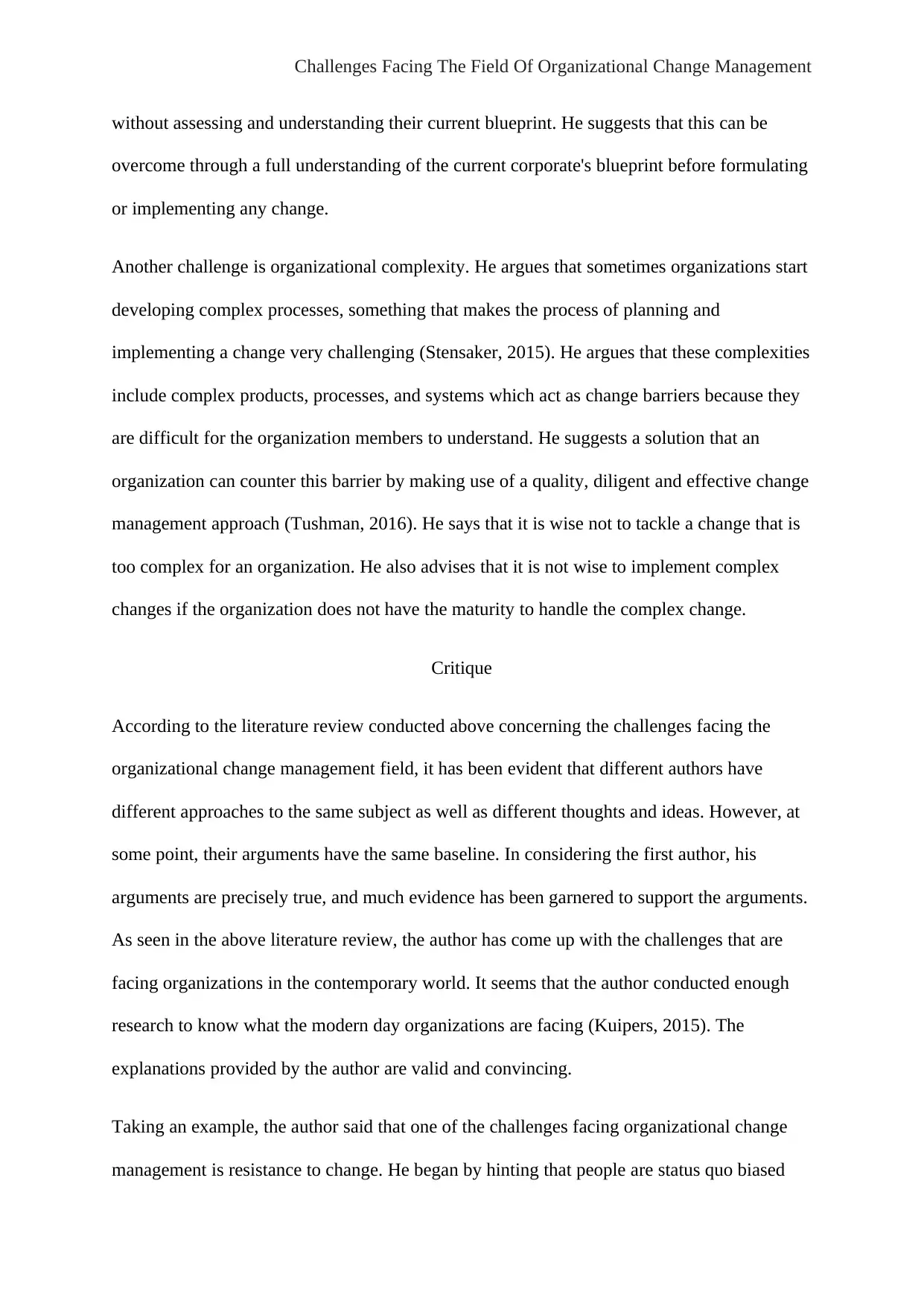
Challenges Facing The Field Of Organizational Change Management
without assessing and understanding their current blueprint. He suggests that this can be
overcome through a full understanding of the current corporate's blueprint before formulating
or implementing any change.
Another challenge is organizational complexity. He argues that sometimes organizations start
developing complex processes, something that makes the process of planning and
implementing a change very challenging (Stensaker, 2015). He argues that these complexities
include complex products, processes, and systems which act as change barriers because they
are difficult for the organization members to understand. He suggests a solution that an
organization can counter this barrier by making use of a quality, diligent and effective change
management approach (Tushman, 2016). He says that it is wise not to tackle a change that is
too complex for an organization. He also advises that it is not wise to implement complex
changes if the organization does not have the maturity to handle the complex change.
Critique
According to the literature review conducted above concerning the challenges facing the
organizational change management field, it has been evident that different authors have
different approaches to the same subject as well as different thoughts and ideas. However, at
some point, their arguments have the same baseline. In considering the first author, his
arguments are precisely true, and much evidence has been garnered to support the arguments.
As seen in the above literature review, the author has come up with the challenges that are
facing organizations in the contemporary world. It seems that the author conducted enough
research to know what the modern day organizations are facing (Kuipers, 2015). The
explanations provided by the author are valid and convincing.
Taking an example, the author said that one of the challenges facing organizational change
management is resistance to change. He began by hinting that people are status quo biased
without assessing and understanding their current blueprint. He suggests that this can be
overcome through a full understanding of the current corporate's blueprint before formulating
or implementing any change.
Another challenge is organizational complexity. He argues that sometimes organizations start
developing complex processes, something that makes the process of planning and
implementing a change very challenging (Stensaker, 2015). He argues that these complexities
include complex products, processes, and systems which act as change barriers because they
are difficult for the organization members to understand. He suggests a solution that an
organization can counter this barrier by making use of a quality, diligent and effective change
management approach (Tushman, 2016). He says that it is wise not to tackle a change that is
too complex for an organization. He also advises that it is not wise to implement complex
changes if the organization does not have the maturity to handle the complex change.
Critique
According to the literature review conducted above concerning the challenges facing the
organizational change management field, it has been evident that different authors have
different approaches to the same subject as well as different thoughts and ideas. However, at
some point, their arguments have the same baseline. In considering the first author, his
arguments are precisely true, and much evidence has been garnered to support the arguments.
As seen in the above literature review, the author has come up with the challenges that are
facing organizations in the contemporary world. It seems that the author conducted enough
research to know what the modern day organizations are facing (Kuipers, 2015). The
explanations provided by the author are valid and convincing.
Taking an example, the author said that one of the challenges facing organizational change
management is resistance to change. He began by hinting that people are status quo biased
⊘ This is a preview!⊘
Do you want full access?
Subscribe today to unlock all pages.

Trusted by 1+ million students worldwide
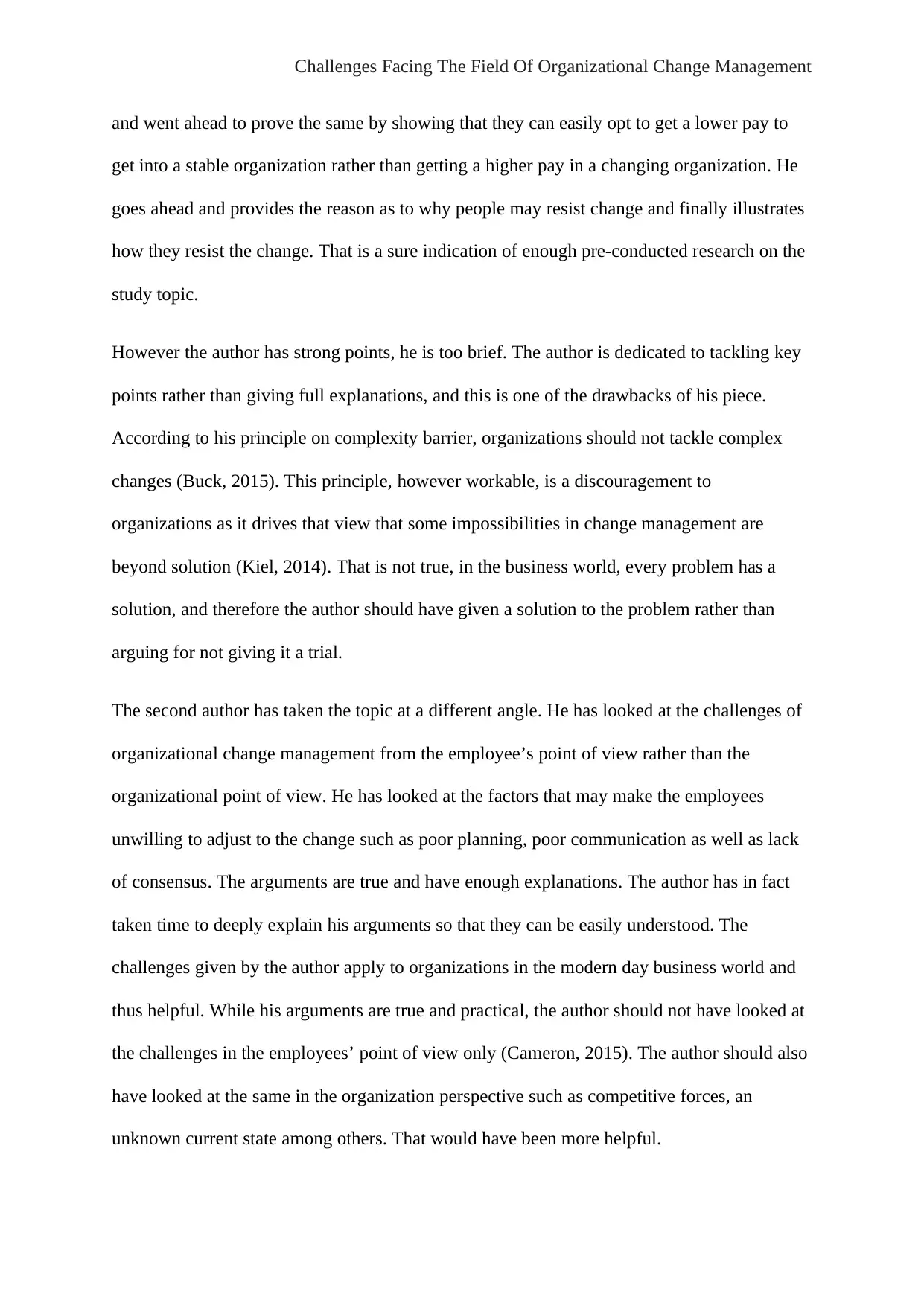
Challenges Facing The Field Of Organizational Change Management
and went ahead to prove the same by showing that they can easily opt to get a lower pay to
get into a stable organization rather than getting a higher pay in a changing organization. He
goes ahead and provides the reason as to why people may resist change and finally illustrates
how they resist the change. That is a sure indication of enough pre-conducted research on the
study topic.
However the author has strong points, he is too brief. The author is dedicated to tackling key
points rather than giving full explanations, and this is one of the drawbacks of his piece.
According to his principle on complexity barrier, organizations should not tackle complex
changes (Buck, 2015). This principle, however workable, is a discouragement to
organizations as it drives that view that some impossibilities in change management are
beyond solution (Kiel, 2014). That is not true, in the business world, every problem has a
solution, and therefore the author should have given a solution to the problem rather than
arguing for not giving it a trial.
The second author has taken the topic at a different angle. He has looked at the challenges of
organizational change management from the employee’s point of view rather than the
organizational point of view. He has looked at the factors that may make the employees
unwilling to adjust to the change such as poor planning, poor communication as well as lack
of consensus. The arguments are true and have enough explanations. The author has in fact
taken time to deeply explain his arguments so that they can be easily understood. The
challenges given by the author apply to organizations in the modern day business world and
thus helpful. While his arguments are true and practical, the author should not have looked at
the challenges in the employees’ point of view only (Cameron, 2015). The author should also
have looked at the same in the organization perspective such as competitive forces, an
unknown current state among others. That would have been more helpful.
and went ahead to prove the same by showing that they can easily opt to get a lower pay to
get into a stable organization rather than getting a higher pay in a changing organization. He
goes ahead and provides the reason as to why people may resist change and finally illustrates
how they resist the change. That is a sure indication of enough pre-conducted research on the
study topic.
However the author has strong points, he is too brief. The author is dedicated to tackling key
points rather than giving full explanations, and this is one of the drawbacks of his piece.
According to his principle on complexity barrier, organizations should not tackle complex
changes (Buck, 2015). This principle, however workable, is a discouragement to
organizations as it drives that view that some impossibilities in change management are
beyond solution (Kiel, 2014). That is not true, in the business world, every problem has a
solution, and therefore the author should have given a solution to the problem rather than
arguing for not giving it a trial.
The second author has taken the topic at a different angle. He has looked at the challenges of
organizational change management from the employee’s point of view rather than the
organizational point of view. He has looked at the factors that may make the employees
unwilling to adjust to the change such as poor planning, poor communication as well as lack
of consensus. The arguments are true and have enough explanations. The author has in fact
taken time to deeply explain his arguments so that they can be easily understood. The
challenges given by the author apply to organizations in the modern day business world and
thus helpful. While his arguments are true and practical, the author should not have looked at
the challenges in the employees’ point of view only (Cameron, 2015). The author should also
have looked at the same in the organization perspective such as competitive forces, an
unknown current state among others. That would have been more helpful.
Paraphrase This Document
Need a fresh take? Get an instant paraphrase of this document with our AI Paraphraser
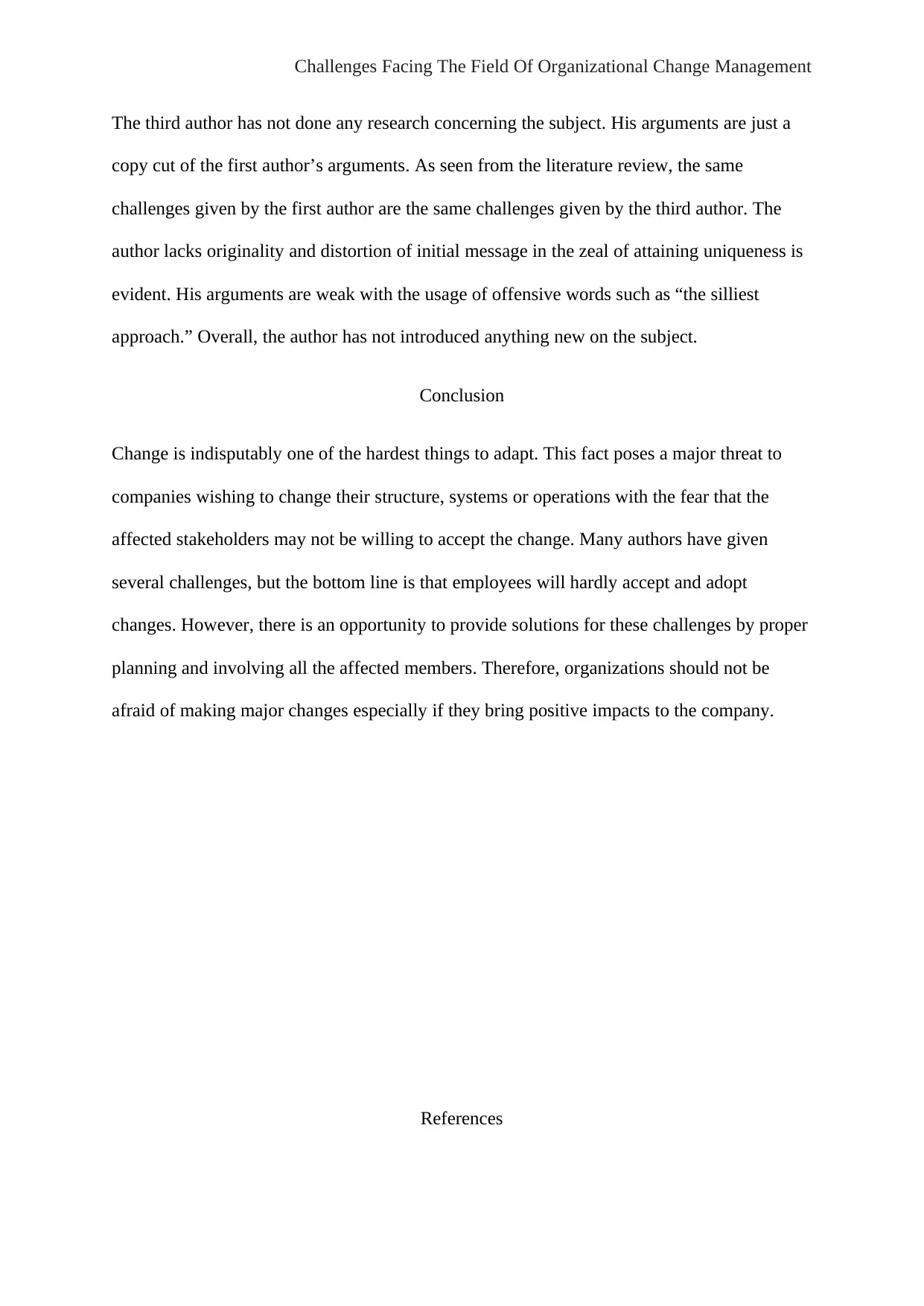
Challenges Facing The Field Of Organizational Change Management
The third author has not done any research concerning the subject. His arguments are just a
copy cut of the first author’s arguments. As seen from the literature review, the same
challenges given by the first author are the same challenges given by the third author. The
author lacks originality and distortion of initial message in the zeal of attaining uniqueness is
evident. His arguments are weak with the usage of offensive words such as “the silliest
approach.” Overall, the author has not introduced anything new on the subject.
Conclusion
Change is indisputably one of the hardest things to adapt. This fact poses a major threat to
companies wishing to change their structure, systems or operations with the fear that the
affected stakeholders may not be willing to accept the change. Many authors have given
several challenges, but the bottom line is that employees will hardly accept and adopt
changes. However, there is an opportunity to provide solutions for these challenges by proper
planning and involving all the affected members. Therefore, organizations should not be
afraid of making major changes especially if they bring positive impacts to the company.
References
The third author has not done any research concerning the subject. His arguments are just a
copy cut of the first author’s arguments. As seen from the literature review, the same
challenges given by the first author are the same challenges given by the third author. The
author lacks originality and distortion of initial message in the zeal of attaining uniqueness is
evident. His arguments are weak with the usage of offensive words such as “the silliest
approach.” Overall, the author has not introduced anything new on the subject.
Conclusion
Change is indisputably one of the hardest things to adapt. This fact poses a major threat to
companies wishing to change their structure, systems or operations with the fear that the
affected stakeholders may not be willing to accept the change. Many authors have given
several challenges, but the bottom line is that employees will hardly accept and adopt
changes. However, there is an opportunity to provide solutions for these challenges by proper
planning and involving all the affected members. Therefore, organizations should not be
afraid of making major changes especially if they bring positive impacts to the company.
References
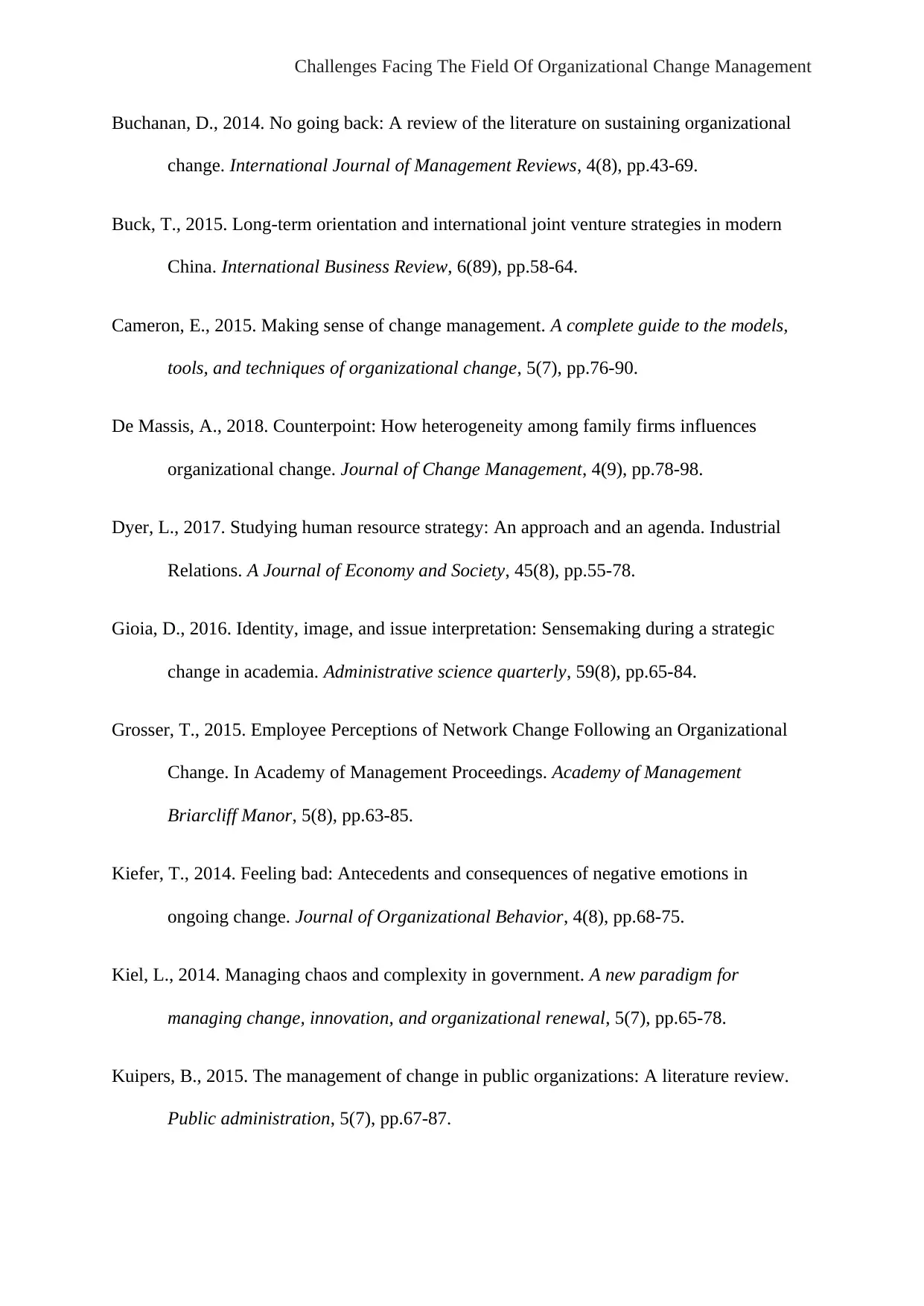
Challenges Facing The Field Of Organizational Change Management
Buchanan, D., 2014. No going back: A review of the literature on sustaining organizational
change. International Journal of Management Reviews, 4(8), pp.43-69.
Buck, T., 2015. Long-term orientation and international joint venture strategies in modern
China. International Business Review, 6(89), pp.58-64.
Cameron, E., 2015. Making sense of change management. A complete guide to the models,
tools, and techniques of organizational change, 5(7), pp.76-90.
De Massis, A., 2018. Counterpoint: How heterogeneity among family firms influences
organizational change. Journal of Change Management, 4(9), pp.78-98.
Dyer, L., 2017. Studying human resource strategy: An approach and an agenda. Industrial
Relations. A Journal of Economy and Society, 45(8), pp.55-78.
Gioia, D., 2016. Identity, image, and issue interpretation: Sensemaking during a strategic
change in academia. Administrative science quarterly, 59(8), pp.65-84.
Grosser, T., 2015. Employee Perceptions of Network Change Following an Organizational
Change. In Academy of Management Proceedings. Academy of Management
Briarcliff Manor, 5(8), pp.63-85.
Kiefer, T., 2014. Feeling bad: Antecedents and consequences of negative emotions in
ongoing change. Journal of Organizational Behavior, 4(8), pp.68-75.
Kiel, L., 2014. Managing chaos and complexity in government. A new paradigm for
managing change, innovation, and organizational renewal, 5(7), pp.65-78.
Kuipers, B., 2015. The management of change in public organizations: A literature review.
Public administration, 5(7), pp.67-87.
Buchanan, D., 2014. No going back: A review of the literature on sustaining organizational
change. International Journal of Management Reviews, 4(8), pp.43-69.
Buck, T., 2015. Long-term orientation and international joint venture strategies in modern
China. International Business Review, 6(89), pp.58-64.
Cameron, E., 2015. Making sense of change management. A complete guide to the models,
tools, and techniques of organizational change, 5(7), pp.76-90.
De Massis, A., 2018. Counterpoint: How heterogeneity among family firms influences
organizational change. Journal of Change Management, 4(9), pp.78-98.
Dyer, L., 2017. Studying human resource strategy: An approach and an agenda. Industrial
Relations. A Journal of Economy and Society, 45(8), pp.55-78.
Gioia, D., 2016. Identity, image, and issue interpretation: Sensemaking during a strategic
change in academia. Administrative science quarterly, 59(8), pp.65-84.
Grosser, T., 2015. Employee Perceptions of Network Change Following an Organizational
Change. In Academy of Management Proceedings. Academy of Management
Briarcliff Manor, 5(8), pp.63-85.
Kiefer, T., 2014. Feeling bad: Antecedents and consequences of negative emotions in
ongoing change. Journal of Organizational Behavior, 4(8), pp.68-75.
Kiel, L., 2014. Managing chaos and complexity in government. A new paradigm for
managing change, innovation, and organizational renewal, 5(7), pp.65-78.
Kuipers, B., 2015. The management of change in public organizations: A literature review.
Public administration, 5(7), pp.67-87.
⊘ This is a preview!⊘
Do you want full access?
Subscribe today to unlock all pages.

Trusted by 1+ million students worldwide
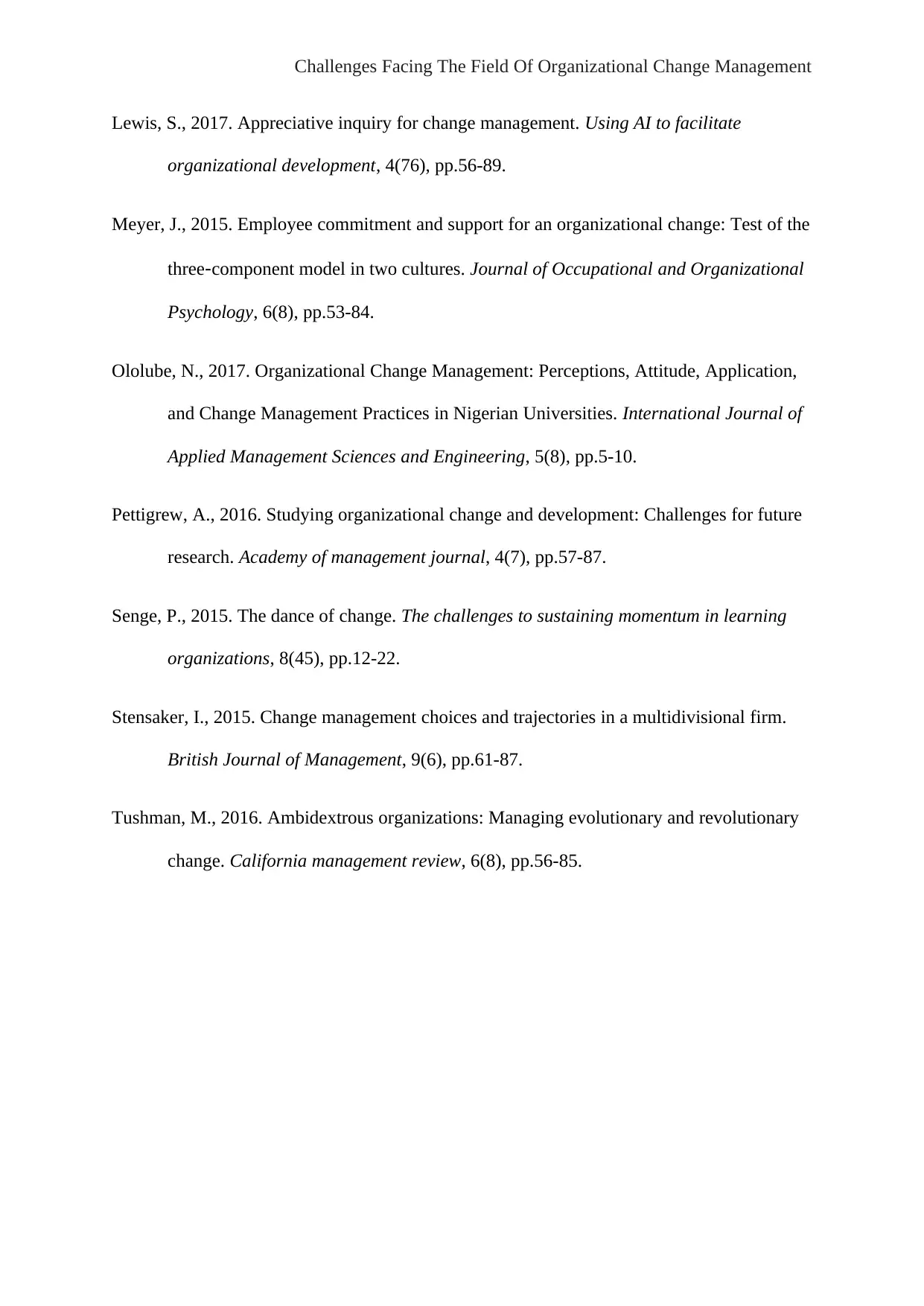
Challenges Facing The Field Of Organizational Change Management
Lewis, S., 2017. Appreciative inquiry for change management. Using AI to facilitate
organizational development, 4(76), pp.56-89.
Meyer, J., 2015. Employee commitment and support for an organizational change: Test of the
three‐component model in two cultures. Journal of Occupational and Organizational
Psychology, 6(8), pp.53-84.
Ololube, N., 2017. Organizational Change Management: Perceptions, Attitude, Application,
and Change Management Practices in Nigerian Universities. International Journal of
Applied Management Sciences and Engineering, 5(8), pp.5-10.
Pettigrew, A., 2016. Studying organizational change and development: Challenges for future
research. Academy of management journal, 4(7), pp.57-87.
Senge, P., 2015. The dance of change. The challenges to sustaining momentum in learning
organizations, 8(45), pp.12-22.
Stensaker, I., 2015. Change management choices and trajectories in a multidivisional firm.
British Journal of Management, 9(6), pp.61-87.
Tushman, M., 2016. Ambidextrous organizations: Managing evolutionary and revolutionary
change. California management review, 6(8), pp.56-85.
Lewis, S., 2017. Appreciative inquiry for change management. Using AI to facilitate
organizational development, 4(76), pp.56-89.
Meyer, J., 2015. Employee commitment and support for an organizational change: Test of the
three‐component model in two cultures. Journal of Occupational and Organizational
Psychology, 6(8), pp.53-84.
Ololube, N., 2017. Organizational Change Management: Perceptions, Attitude, Application,
and Change Management Practices in Nigerian Universities. International Journal of
Applied Management Sciences and Engineering, 5(8), pp.5-10.
Pettigrew, A., 2016. Studying organizational change and development: Challenges for future
research. Academy of management journal, 4(7), pp.57-87.
Senge, P., 2015. The dance of change. The challenges to sustaining momentum in learning
organizations, 8(45), pp.12-22.
Stensaker, I., 2015. Change management choices and trajectories in a multidivisional firm.
British Journal of Management, 9(6), pp.61-87.
Tushman, M., 2016. Ambidextrous organizations: Managing evolutionary and revolutionary
change. California management review, 6(8), pp.56-85.
1 out of 10
Related Documents
Your All-in-One AI-Powered Toolkit for Academic Success.
+13062052269
info@desklib.com
Available 24*7 on WhatsApp / Email
![[object Object]](/_next/static/media/star-bottom.7253800d.svg)
Unlock your academic potential
Copyright © 2020–2025 A2Z Services. All Rights Reserved. Developed and managed by ZUCOL.




